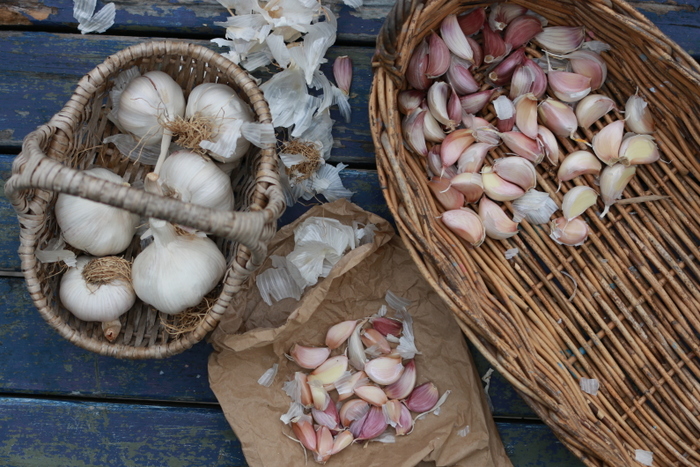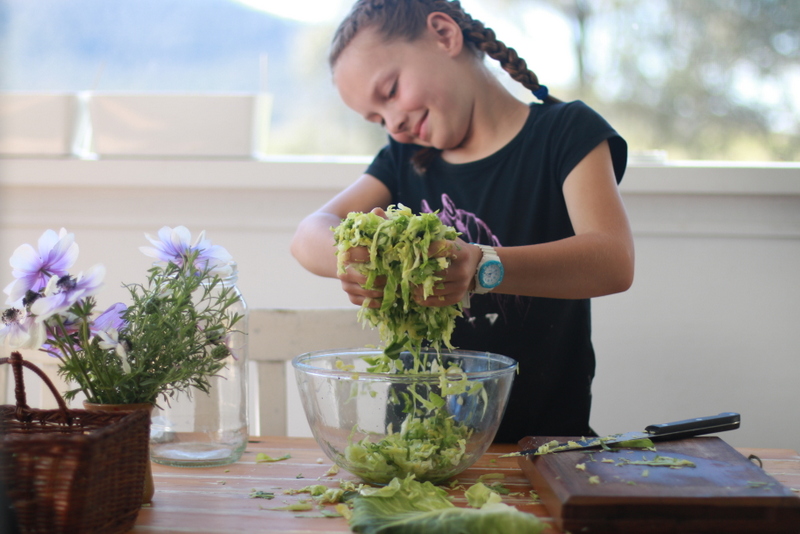Autumn is garlic planting time. An old gardener once told me that garlic needs to be in the ground before St Patrick’s Day. St Patrick's Day usually falls around the Autumn equinox (in the southern hemisphere) – so it's a nice reminder of a good time to plant garlic. For those of us in temperate or warmer climates, plant any later and the bulbs may not have time to fully form. It's a rule I've stuck to for the past few years – and I wasn't about to break it. So just few days before St Patrick's day I was scrambling to prepare a new bed for garlic.
Soil preparation is the key to growing good garlic.
Choose a sunny location and make sure the soil has good drainage, is high in organic matter, and has a neutral to slightly alkaline pH. The “well-drained” is especially important – as garlic bulbs don't like being water-logged.
Garlic is also suited to growing in pots.
In previous years I've planted my garlic in soil enriched with mushroom compost. Mushroom compost tends to be alkaline – so suits garlic which dislikes acidic soil. This year I didn't have any mushroom compost handy, so instead dug in worm castings and compost. I added a generous dose of lime to reduce soil acidity. If I was more organised I would have also proceeded planting with a green manure crop – dug in to increase organic matter.
I tried something different with my garlic bed this year. My garden was still drowning in pumpkins – but I didn't want to delay planting any longer. The only bare ground I could quickly and easily turn into a garden bed was in the chook run. I used some local cheap spoilt hay as an edge, and covered with some mesh I had. I ended up with an easy and frugal straw bale-style garden bed that the chickens can't scratch.
Garlic doesn't like to compete with weeds, so heavy mulching is important.
Mulch can be added before planting, or after once the plants emerge. Mulch with whatever is locally available. This year I mulched heavily before planting with aged wood chips. In previous years I've used straw or lucerne hay.
Garlic is grown from bulbs separated into cloves.
Bulbs can be sourced from garden supply stores, a gardening friend, or an organic greengrocer. Supermarket garlic won't be suitable as it's likely been treated to prevent it from sprouting.
I used cloves saved from last year's crop. I bought a couple of bulbs from Green Harvest a few seasons ago and have been gradually been building up numbers. I planted 100 cloves this year.
Separate bulbs into cloves once you are ready to plant. Larger cloves will produce larger bulbs, so use only the large cloves for planting. The smaller cloves can be eaten.
Plant cloves at least 15 cm apart and make sure the tip of the clove appears just above the surface of the soil or mulch. The flatter or root end should be pointing down. Although don't worry too much about getting this right as commercial growers simply drop cloves in any which way and they eventually turn the right way up.
Water well – and don't water again until shoots appear. The garlic will shoot within days. Mine was up in just a few days and now a fortnight later is already 10 cm high.
Once planted, garlic is easy to look after.
Keep weeds under control by topping up mulch when needed.
I apply seaweed fertiliser and worm wee in spring.
It's important to keep soil consistently damp (but not waterlogged) during dry periods.
Stop watering around a month before harvest once the bulbs are fully formed and the leaves have started to brown.
Garlic is slow food at its best and won't be ready to harvest until around eight months after planting. I usually harvest mine in late November.
There's still time for you to plant your own garlic. Grab a few pots or prepare a bed, plant some cloves, and you'll be enjoying home grown garlic before Christmas. That seems a long way away – but home grown garlic is worth the wait.
Originally published in the Newcastle Herald Monday 23rd March 2015.



